Rajasthan
Things to Do
Delhi
Delhi is the capital of India and its third largest city. The city actually consists of two parts. Old Delhi was the capital of
Muslim India between the 12th and 19th centuries. In Old Delhi you will find many mosques, monuments and forts relating to India's Muslim
history.
The other delhi is New Delhi, the imperial city created as a capital of India by the British. It is a spacious, open city and contains
many embassies and government buildings.
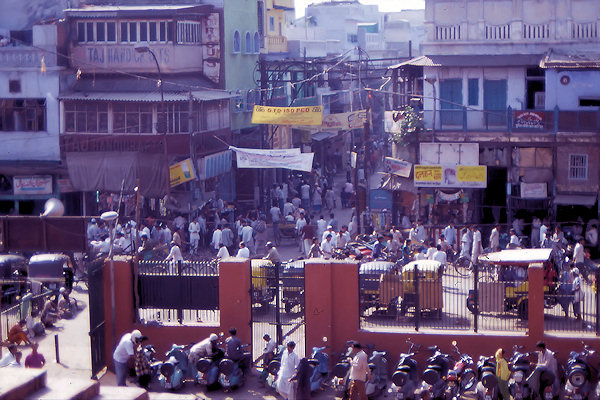 |
|||||
In addition to its historic interest and role as the government centre, New Dehli is a major travel gateway.
It is one of India's busiest entrance points for overseas airlines, the hub of the north Indian travel network and is on the overland
route across Asia.
Old Delhi
Old Delhi was founded as Shahjahanabad in 1639, when Shah Jahan, the Mughal emperor at the time, decided to shift the Mughal capital from
Agra.
The construction of the city was completed in 1648, and it remained the capital of the Mughal Empire until its fall in 1857, when the
British Raj took over a paramount power in India.
It was once filled with mansions of nobles and members of the royal court, along with elegant mosques and gardens.
The main street of Old Delhi is the colourful shopping bazaar known as Chandni Chowk. It's hopelessly congested day and night, a very
sharp contrast to the open spacious streets of New Delhi.
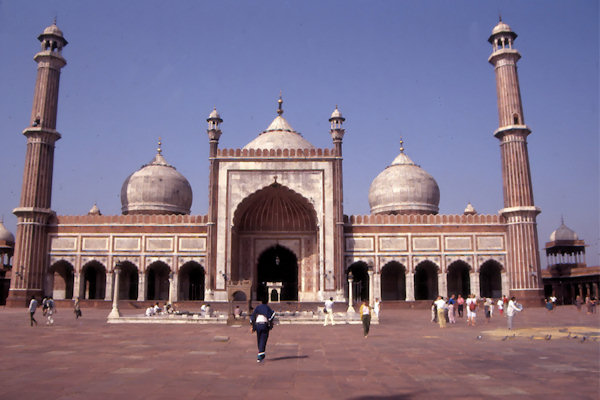 |
|||||
Masjid e Jahan Numa
The Masjid e Jahan Numa, commonly known as the Jama Masjid of Delhi, is one of the largest mosques in India.
It was built by the Mughal Emperor Shah Jahan between 1650 and 1656 at a cost of one million rupees. The mosque was completed in 1656 AD
with three great gates and two 40 metres high minarets constructed with strips of red sandstone and white marble. The courtyard can accommodate
more than 25.000 people.
Red Fort
The red sandstone walls of Lal Qila, the Red Fort, extend for two km and vary in height from 18 meters on the river side to 33 meters
on the city side.Shah Jahan started construction of the massive fort in 1638 and it was completed in 1648.
The Red Fort dates from the very peak of Monghul power. When the emperor rode out on elephant back into the streets of old delhi it was a
display of pomp and power at its most magnificent.
Today, the fort is typically Indian with would-be guides leaping forth to offer their services as soon as you enter.
The Naubat Khana, is the drum house that stands at the entrance between the outer and inner court at the Red Fort.
Musicians from the Naubat Khana would announce the arrival of the emperor and other dignitaries at the court of public audience. Music was
also played five times a day at chosen hours.
Agra
If there's a building which represents a country it has to be the Taj Mahal for India. This most famous Moghul monument was
constructed by Emperor Shah Jahan in memory of his wife Mumtaz Mahal, the "Lady of the Taj"
It has been described as the most extravagant monument ever built for love, for the emperor was heartbroken when Mumtaz,
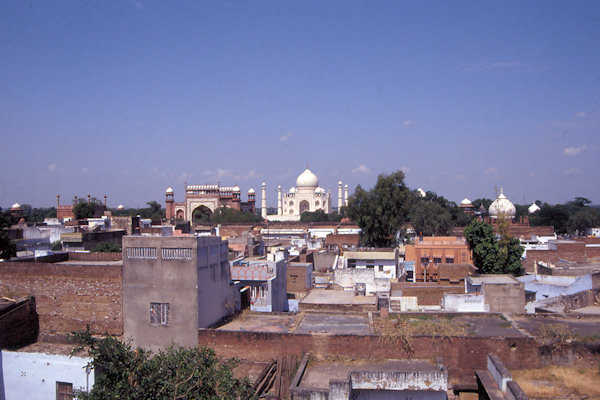 |
|||||
to whom he had been married for 17 years, died in 1629 in childbirth, after producing 14 children.
Construction of the Taj began in 1631 and was not completed until 1653.
The Taj Mahal stands on a raised marble platform with tall white minarets at each corner of the platform. They are just for decoration; nobody
is called to prayer from them. The central structure has four small domes surrounding the huge, bulbous, central dome.
The tombs of Muntaz Mahal and Shan Jahan are in a basement room. Above them in the main chamber are false tombs, a commonpractice in Indian
mausoleums of this type.
Although the Taj is amazingly graceful from almost any angle, it's the close-up detail which is realy astounding. Semiprecious stones are
inlaid into the marble in beautiful patterns and which superb craft in a process known as "pietra dura"
The building, which stands beside the Yamuna River, is in a large formal garden You enter the Taj grounds through a high red sandstone gateway
inscribed with verses from the Koran in Arabic.
Fatehpur Sikri
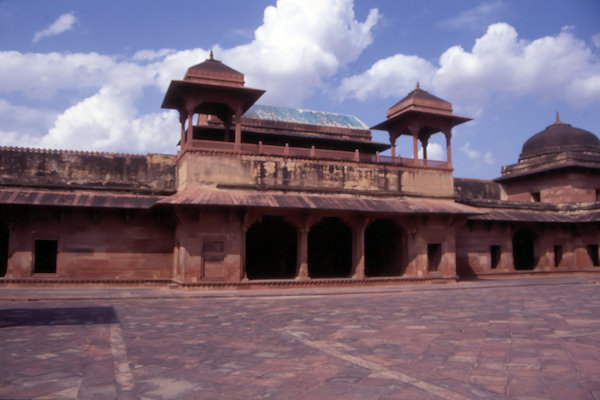 |
|||||
Legend says that Emperor Akbar, who reigned from 1556 to 1605 was without a male heir and made a pilgrimage to this spot to see the
saint Shaikh Salim Christi.
The saint foretold the birth of Akbar's son, the future Emperor Jehangir and in gratitude Akbar named his son Salim.
Furteremore Akbar transferred his capital to Sikri and built a new and splendid city. Later, however, the city was abandoned due, it is said,
to difficulties with the water supply.
Panch Mahal
This amusing little "Five Story Palace" was probably once used by the ladies of the court and originally had stone screens on the
sides.
This is one of the most important buildings in Fatehpur Sikri. This is an extraordinary structure employing the design elements of a
Buddhist Temple; entirely columnar, consisting of four stories of decreasing size arranged asymmetrically on the ground floor, which
contains 84 columns.
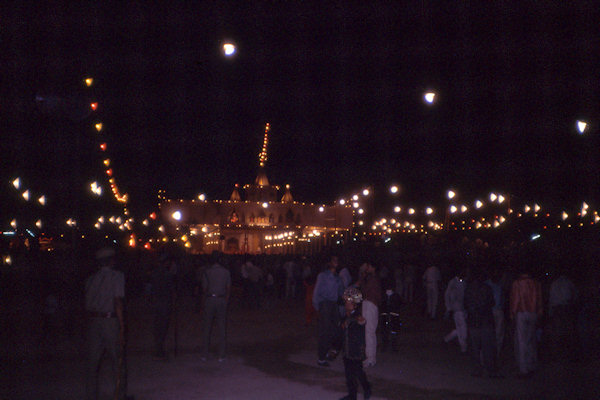 |
|||||
Dussehra
This is the most popular of all the Indian festivals and cellebrates Rama's victory over the demon king Ravana; it culminates with the
burning of hudge images of Ravana and his accomplices.
Ravana plays an important role in the Ramayana.
Ravana had a sister known as Shoorpanakha. She fell in love with the brothers Rama and Lakshamana and wanted to marry
one of them. Lakshamana refused to marry her and Rama could not as he was already married to Sita.
Shoorpanakha threatened to kill Sita, so that she could marry Rama. This angered Lakshamana who cut off Shoorpanakha's nose and ears. Ravana
then kidnapped Sita to avenge his sister's injuries.
Rama and Lakshamana later fought a battle to rescue Sita. The monkey god Hanuman and a huge army of monkeys helped them.
Jaipur
The city owes his name, its foundation and its careful planning to the great warrior-astronomer Maharaja Jai Singh II (1699-1744).
His predecessors had enjoyed good relations with the Moghuls and Jai Singh was careful to cultivate this alliance.
In 1727, when Moghul power on the wane, Jai Singh decided the time was ripe to move down from his somewhat cramped hillside fortress at nearby
Amber to a new site on the plains. He laid out the city, with its surrounding walls and six rectangular blocks, according to principles of
town planning set down in the Shilpa-Sastra, an ancient Hindu treatise on architecture.
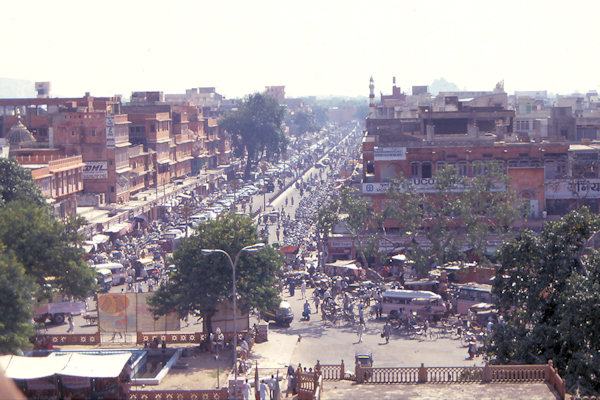 |
|||||
Hawa Mahal
Built in 1799, the Hawa Mahal, or Palace of the Winds, is one of Jaipur's major landmarks, although it is actually little more than a
facade.
This five-story building, which looks out over the main street of the old city, is a stunning example of Rajput artistry with its pink,
semioctagonal and delicately honeycombed sandstone windows.
It was originally built to enable ladies of the royal household to wach the everyday life and processions of the city.
City Palace
In the heart of the old city, the City Palace occupies a large area divided into series of courtyards, gardens and buildings.
The outer wall was built by Jai Singh but other additions are much more recent, some dating to the start of this century.
Outside the buildings, you can see a large silver vessel in which a former maharaja used to take drinking water with him to England.
Being a devout Hindu, he could not drink the English water!
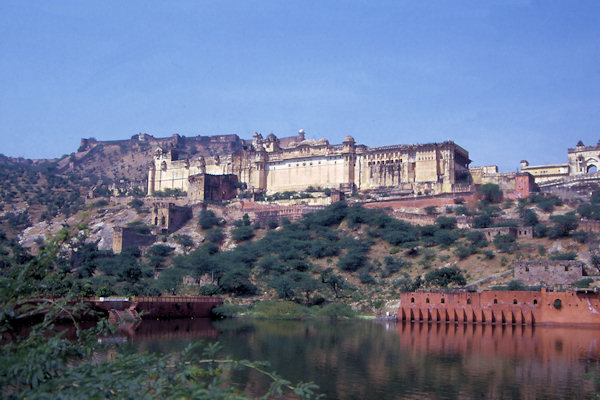 |
|||||
Amber Palace
About 11 km out of Jaipur, Amber was once the ancient capital of Jaipur state.
Construction of the fortress-palace was begun in 1592 by Raja Man Singh, the Rajput commander of Akbar's army. It was later extended
and completed by the Jai Sings before the move to Jaipur on the planes below.
The maharaja's apartments are on an the higher terrace - you enter through the Ganesh Pol - a gateway decorated with mosaics
and sculptures.
The courtyard has two buildings, one opposite to the other, separated by a garden laid in the fashion of the Mughal Gardens.
The building to the left of the entrance gate is called the Jai Mandir, which is exquisitely embellished with glass inlaid panels
and multi-mirrored ceilings. The mirrors are of convex shape and designed with coloured foil and paint which would glitter bright under
candlelight at the time it was in use.
Also known as Sheesh Mahal (mirror palace), the building was built by King Man Singh in the 16th century and completed in 1727.
Udaipur
Founded in 1567 by Maharana Udai Singh following the final sack of Chittogarh by the Mogul emperor Akbar, Udaipur rivels
any of the world-famous creations of the Moghulls with its Rajput love of the whimsical and its superbly crafted elegance.
Its also proud of its heritage as a centre for the performing arts, painting and crafts. And, since water is relatively plentiful in this
part of the state, there are plenty of parks and gardens, many of which line the lake shores.
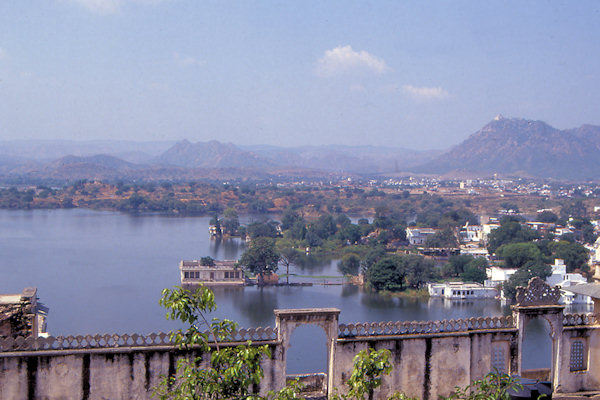 |
|||||
Lake Pichola
The beautiful Lake Pichola was enlarged by Maharana Udai Singh after he founded the city and now measures four km in length and three km wide.
Nevertheless, it remains fairly shallow and can actually dry up in severe droughts.
Jingniwas
Jigniwas, the Lake Palace island, is about 1 1/2 hectares in size. The palace was built by Maharana Jagat Singh II in1754 and covers
the whole island.
Today, it has been converted into a luxury hotel with courtyards, fountains, gardens and a swimming pool.
City Palace
Actually a conglomerattion of buildings added by various maharanas, the palace manages to retain a surprisingly uniformity of design.
The main part of the palace is now preserved as a museum, which includes the Mor Chowk with its beautiful mosaics of peacocks, the
favourite Rajasthani bird.
Varanasi
Varanasi, the "eternal city", is one of the most important pilgrimage sites in India and also a major tourist attraction.
Situated on the banks of the sacred Ganges, Varanasi has been a centre of learning and civilisation for over 2.000 years.
It was at Sarnath only 10 km away that the Buddha first preached his massage of enlightenment, 25 centuries ago. Later the city
became a great Hindu centre, but was looted a number of times by Muslim invaders from the 11th century
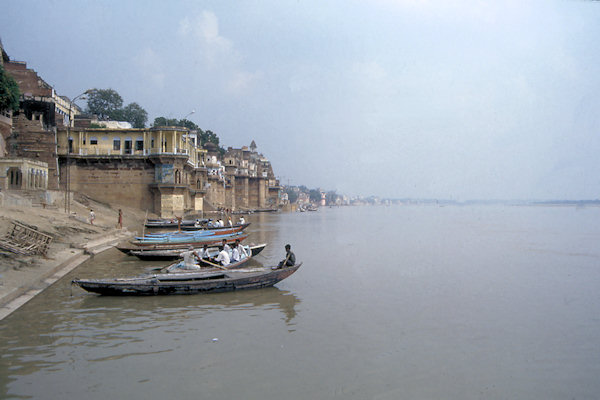 |
|||||
The Gats
Varanasi'sprincipal attraction is the long string of bathing ghats which line the west bank of the Ganges.
Gats are the steps which lead down to the river where pilgrims make their soul-cleansing dip in the river and where, at the two "burning
gats" bodies are cremated.
The best time to visit the gats is at dawn when pilgrims take their early morning dip-the city comming alive, the light is magical and
Varanasi is an exotic place.
Look out for the people on the gats - the woman bathing discreetly in their saris, the young man going through contortionist yoga exercises,
the Brahmin priest offereng blessings and the ever-present beggars giving others an opportunity to do there karma some good.